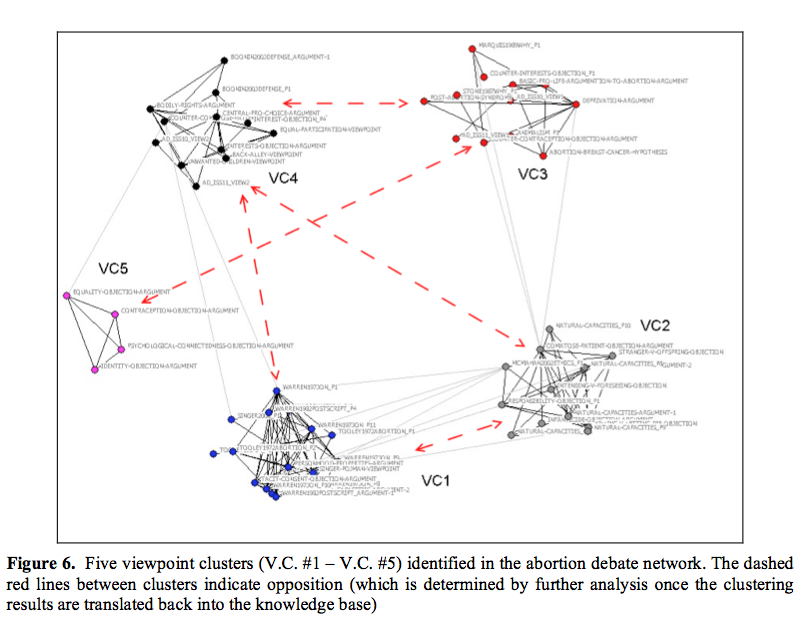Ontological foundations for scholarly debate mapping technology
Citation: Neil Benn, Simon Buckingham Shum, John Domingue, Clara Mancini (2008) Ontological foundations for scholarly debate mapping technology. Computational Models of Argument (RSS)
Internet Archive Scholar (search for fulltext): Ontological foundations for scholarly debate mapping technology
Download: http://oro.open.ac.uk/11939/
Tagged: Computer Science
(RSS) argumentation (RSS), knowledge engineering (RSS), cognitive coherence relations (RSS), ontologies (RSS)
Summary
This paper uses techniques from two domains: bibliometrics and knowledge management. It presents a reference ontology for "knowledge domain analytics" and defines inference rules for this ontology using two key relationships (polarity and strength). That background is used to cluster information manually extracted from Wikipedia's article about the abortion debate, revealing some additional information.
A reference ontology
The Core KDA ontology specializes SemODP. SemODP Semiotic Ontology Design Pattern http://www.loa-cnr.it/ontologies/cDnS.owl (Behrendt, W., et al. Towards an ontology-based distributed architecture for paid content. in The Semantic Web: Research and Applications, 2nd European Semantic Web Conference (ESWC 2005). 2005. Heraklion, Crete, Greece: Springer-Verlag. ) is constructed as a reference ontology for "knowledge domain analytics", which includes both quantitative and qualitative analysis, and has 3 classes.
Here are the correspondences between Core KDA (mkda) and SemODP (cdns).
- mkda:Person, mkda:Organisation - cdns:Agent
- mkda:Publication - cdns:InformationObject -
- mkda:PropositionalContent, mkda:NonPropositionalContent - cdns:Description
Table 1 provides a crosswalk to 4 ontologies (used by various tools): swrc (Bibster), eskimo (ESKIMO), scholonto (ClaiMaker), and akt (CS AKTIVE SPACE).
The authors also make explicit their assumption that knowledge representation and communication are major activities, and semiotic ones.
Combining KDA with Cognitive Coherence Relations
The theoretical framework comes from Modelling discourse in contested domains: A semiotic and cognitive framework, which uses two key cognitive coherence relations (based on Towards a taxonomy of coherence relations):
- Additive/Causal - do they have a weak or strong connection? (compare 'and' to 'because', or a list to a motivation)
- Positive/Negative - does the expected connection hold? (compare `so' to `yet')
These relations are used to define a "grammar" for relationships between publications, persons/organizations, and arguments in the KDA ontology. Due to the small number of combinations, there are only "a limited set" of inference rules. (Figure 2 provides an example of three such rules.)
These rules are then used for a case study.
Case Study
Wikipedia's article on Abortion Debate is used to populate a knowledge base with Issues. The underlying propositions and arguments are further added. Then information about publications and authors is coded.
With the knowledge base populated, the inference rules are used; this "results in a network representation with a single +ADDITIVE link type", which is appropriate input for bibliometrics. Then Netdraw software is used to cluster and visualise the positions:  As noted, the goal is "to detect interesting phenomena that will motivate more focussed investigation on the part of the analyst." The analyst determines who is associated with each cluster, which is used to determine "opposing" clusters (clusters were at least half the viewpoints have a 'disputes' relation with the viewpoints in the other cluster."). Those opposing clusters are shown as red dashed lines in the figure.
As noted, the goal is "to detect interesting phenomena that will motivate more focussed investigation on the part of the analyst." The analyst determines who is associated with each cluster, which is used to determine "opposing" clusters (clusters were at least half the viewpoints have a 'disputes' relation with the viewpoints in the other cluster."). Those opposing clusters are shown as red dashed lines in the figure.
Viewpoint clusters add value by reducing the complexity and by adding information (for example, the authors find that Jeff McMahan is associated with two clusters which oppose each other).
Theoretical and Practical Relevance
In addition to its theoretical value, this paper may be useful for students trying to understand the many perspectives on the abortion debate (see especially Table 2 which summarizes viewpoints and authors).
Distinguishes micro-argumentation and macro-argumentation -- which could be helpful elsewhere.